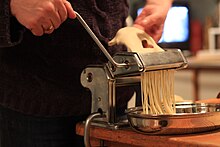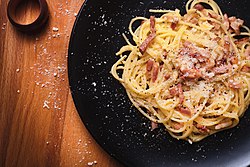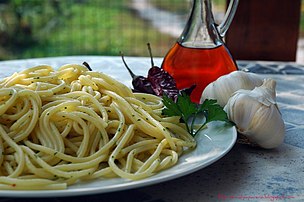Spaghetti
This article needs additional citations for verification. (October 2024) |
 Spaghetti hung to dry | |
| Type | Pasta |
|---|---|
| Place of origin | Italy |
| Main ingredients | Semolina or flour, water |
Spaghetti (Italian: [spaˈɡetti]) is a long, thin, solid, cylindrical pasta.[1] It is a staple food of traditional Italian cuisine.[2] Like other pasta, spaghetti is made of milled wheat, water, and sometimes enriched with vitamins and minerals. Italian spaghetti is typically made from durum-wheat semolina.[3] Usually the pasta is white because refined flour is used, but whole wheat flour may be added.[4] Spaghettoni is a thicker form of spaghetti, while spaghettini is a thinner form. Capellini is a very thin spaghetti, while vermicelli refers to intermediate thicknesses.
Originally, spaghetti was notably long, but shorter lengths gained in popularity during the latter half of the 20th century and now it is most commonly available in 25–30 cm (10–12 in) lengths. A variety of pasta dishes are based on it and it is frequently served with tomato sauce, meat or vegetables.
Etymology
Spaghetti is the plural form of the Italian word spaghetto, which is a diminutive of spago, meaning 'thin string' or 'twine'.[1]
History
Origin
The first written record of pasta comes from the Talmud in the 5th century AD and refers to dried pasta that could be cooked through boiling,[5] which was conveniently portable.[6] Some historians think that Arabs introduced pasta to Europe during a conquest of Sicily. In the West, it may have first been worked into long, thin forms in Sicily around the 12th century, as the Tabula Rogeriana of Muhammad al-Idrisi attested, reporting some traditions about the Kingdom of Sicily.[7]

The popularity of spaghetti spread throughout Italy after the establishment of spaghetti factories in the 19th century, enabling the mass production of spaghetti for the Italian market.[8]
Ingredients
Spaghetti is made from ground grain (flour) and water.[9] Whole-wheat and multigrain spaghetti are also available.[3]
Production
Fresh spaghetti

Pasta can be made at home, cutting sheets of flattened dough with a knife into ribbons,[10] rather than spaghetti with circular cross-section. Some pasta machines have a spaghetti attachment with circular holes that extrude spaghetti, or shaped rollers that form cylindrical noodles.[11]
Spaghetti can be made by hand by manually rolling a ball of dough on a surface to make a long sausage shape. The ends of the sausage are pulled apart to make a long thin sausage. The ends are brought together and the loop pulled to make two long sausages. The process is repeated until the pasta is sufficiently thin. The pasta knobs at each end are cut off leaving many strands which may be hung up to dry.[12]
Fresh spaghetti is usually cooked within hours of being formed. Commercial versions of fresh spaghetti are manufactured.[13]
Dried spaghetti
The bulk of dried spaghetti is produced in factories using auger extruders. While essentially simple, the process requires attention to detail to ensure that the mixing and kneading of the ingredients produces a homogeneous mix, without air bubbles. The forming dies have to be water cooled to prevent spoiling of the pasta by overheating. Drying of the newly formed spaghetti has to be carefully controlled to prevent strands sticking together, and to leave it with sufficient moisture so that it is not too brittle. Packaging for protection and display has developed from paper wrapping to plastic bags and boxes.[14]
-
A hydraulic press with an automatic spreader by the Consolidated Macaroni Machine Corporation, Brooklyn, New York. This machine was the first to spread long cut alimentary paste products onto a drying stick.
-
An industrial dryer for spaghetti or other long goods pasta products, also by the Consolidated Macaroni Machine Corporation
-
Dried spaghetti
-
Dried spaghetti measured with a "spaghetti measure". One portion of dried pasta weighs 116 g (4+1⁄8 oz), twice the amount of one serving on the package (12 mm circle or 60 g.). The measure can portion out 1, 2, 3, or 4 servings based on the diameter of the circle.
Preparation
Fresh or dry spaghetti is cooked in a large pot of salted, boiling water and then drained in a colander (Italian: scolapasta).
In Italy, spaghetti is generally cooked al dente (lit. 'to the tooth'), fully cooked but still firm to the bite. It may also be cooked to a softer consistency.
Spaghettoni is a thicker spaghetti which takes more time to cook. Spaghettini is a thinner form which takes less time to cook. Capellini is a very thin form of spaghetti which cooks very quickly.
Utensils used in spaghetti preparation include the spaghetti scoop and spaghetti tongs.
-
Spaghetti being placed into a pot of boiling water for cooking
-
Draining the water from boiled spaghetti
-
A spaghetti scoop
-
Spaghetti tongs
Serving
Italian cuisine
This section needs additional citations for verification. (October 2024) |

An emblem of Italian cuisine, spaghetti is frequently served with tomato sauce, which may contain various herbs (especially oregano and basil), olive oil, meat, or vegetables. Other spaghetti preparations include amatriciana or carbonara. Grated hard cheeses, such as pecorino romano, Parmesan, and Grana Padano, are often sprinkled on top.[citation needed]
Below are some of the most important spaghetti dishes:
- Spaghetti alla puttanesca (lit. 'spaghetti whore-style') – a tangy, somewhat salty Italian pasta dish invented in the mid-20th century. The ingredients are typical of southern Italian cuisine: tomatoes, olive oil, olives, capers, and garlic.[15]
- Spaghetti alle vongole (lit. 'spaghetti with clams') – very popular throughout Italy, especially its central regions, including Rome and further south in Campania (where it is part of traditional Neapolitan cuisine)
- Spaghetti aglio e olio (lit. 'spaghetti garlic and oil') – a traditional Italian pasta dish coming from Naples[16]
- Spaghetti alla Nerano – from the village of Nerano, near Naples. With fried zucchinis and a local variant of provolone cheese.[17][18]
- Spaghetti dishes
International cuisine

In the Philippines, a popular variant is the Filipino spaghetti, which is distinctively sweet with the tomato sauce sweetened with banana ketchup or sugar. It typically uses a large amount of giniling (ground meat), sliced hot dogs, and cheese. The dish dates back to the period between the 1940s to the 1960s. During the American Commonwealth Period, a shortage of tomato supplies in the Second World War forced the development of the banana ketchup.[19][20][21] Spaghetti was introduced by the Americans and was tweaked to suit the local Filipino predilection for sweet dishes.[22]
Sapaketti phat khi mao (spaghetti fried drunken noodle style) is a popular dish in Thai cuisine.[23]
Spaghetti is a main part of laksa Johor, a specialty from Johor, Malaysia.[24]
Consumption
By 1955, annual consumption of spaghetti in Italy doubled from 14 kilograms (31 lb) per person before World War II to 28 kilograms (62 pounds).[25] By that year, Italy produced 1,432,990 tons of spaghetti, of which 74,000 were exported, and had a production capacity of 3 million tons.[25]
Nutrition
| Nutritional value per 70 g (2+1⁄2 oz) | |||||||||||||||||||||||
|---|---|---|---|---|---|---|---|---|---|---|---|---|---|---|---|---|---|---|---|---|---|---|---|
| Energy | 460 kJ (110 kcal) | ||||||||||||||||||||||
22g | |||||||||||||||||||||||
| Sugars | 0g | ||||||||||||||||||||||
| Dietary fiber | 1g | ||||||||||||||||||||||
0.5g | |||||||||||||||||||||||
| Saturated | 0g | ||||||||||||||||||||||
| Trans | 0g | ||||||||||||||||||||||
4g | |||||||||||||||||||||||
| |||||||||||||||||||||||
Source: USDA[26] | |||||||||||||||||||||||
| †Percentages estimated using US recommendations for adults,[27] except for potassium, which is estimated based on expert recommendation from the National Academies.[28] | |||||||||||||||||||||||
Pasta provides carbohydrates, along with some protein, iron, dietary fiber, potassium, and B vitamins.[29] Pasta prepared with whole wheat grain provides more dietary fiber[29] than that prepared with degermed flour.
In popular culture

Poorly structured computer source code is often described as spaghetti code.[30]
In women's clothing, very thin straps supporting a dress or topwear are called "spaghetti straps".[31]
The term spaghetti Western was used by American critics and those in other countries because most of the Western movies made in Europe were produced and directed by Italians.[32]
In the 1955 animated movie Lady and the Tramp, the sequence of the title characters sharing a plate of spaghetti—climaxed by an accidental kiss as they swallow opposite ends of the same strand of spaghetti—is considered an iconic scene in American film history.[33]
The BBC television program Panorama featured a hoax program about the spaghetti harvest in Switzerland on April Fools' Day in 1957.[34]
See also
![]() Media related to Spaghetti at Wikimedia Commons
Media related to Spaghetti at Wikimedia Commons
![]() The dictionary definition of spaghetti at Wiktionary
The dictionary definition of spaghetti at Wiktionary
- List of pasta
- Spaghetti alla chitarra (or maccheroni alla chitarra)
References
- ^ a b spaghetti. Dictionary.com. Dictionary.com Unabridged (v 1.1). Random House, Inc. (accessed: 3 June 2008).
- ^ Montanari, Massimo (November 16, 2021). A Short History of Spaghetti with Tomato Sauce: The Unbelievable True Story of the World's Most Beloved Dish. Europa Editions. ISBN 978-1-60945-710-5.
- ^ a b "How to Make Spaghetti". Better Homes and Gardens. Retrieved on 22 December 2014.
- ^ Suo, Xinying; Pompei, Francesca; Bonfini, Matteo; Mustafa, Ahmed M.; Sagratini, Gianni; Wang, Zhangcun; Vittadini, Elena (March 1, 2023). "Quality of wholemeal pasta made with pigmented and ancient wheats". International Journal of Gastronomy and Food Science. 31: 100665. doi:10.1016/j.ijgfs.2023.100665. hdl:11581/468816. ISSN 1878-450X.
- ^ "Pasta is Not Originally from Italy". www.todayifoundout.com. June 3, 2011. Retrieved on 22 December 2014.
- ^ "History and Origin of Pasta". www.101cookingrecipes.com. Retrieved January 16, 2017.
- ^ Kummer, Corby (July 1, 1986). "Pasta". The Atlantic.
- ^ Whiteman, Kate; Boggiano, Angela; Wright, Jeni (2007). The Italian kitchen bible. Hermes House. pp. 12–13. ISBN 978-1-84038-875-6.
- ^ Gisslen, Wayne; Griffin, Mary Ellen; Le Cordon Bleu (2006). Professional Cooking for Canadian Chefs. John Wiley & Sons. p. 635. ISBN 0471663778.
- ^ "Homemade Spaghetti". Instructables.com. October 16, 2008. Retrieved December 19, 2014.
- ^ Conran, Caroline (1997). The Essential Cook Book: The Back-to-basics Guide to Selecting, Preparing, Cooking, and Serving, the Very Best Of Food. New York, New York: Stewart, Tabori & Chang. pp. 229, 239. ISBN 978-1556706028. Retrieved August 15, 2024.
- ^ Luke Rymarz (June 24, 2008). "How To Make Hand-Pulled Noodles: Part 2 of 2, Pulling". YouTube. Archived from the original on December 11, 2021.
- ^ "Fresh Spaghetti". Metro. April 17, 2023.
- ^ "Pasta Manufacturing" (PDF). Epa.gov. August 1995. Retrieved December 19, 2014.
- ^ Zanini De Vita & Fant 2013, p. 68.
- ^ "Spaghetti Aglio Olio e Peperoncino, the "Why-Not?" Midnight Pasta". La Cucina Italiana. November 17, 2019. Retrieved June 18, 2024.
- ^ "Spaghetti alla Nerano". La Cucina Italiana. August 29, 2023. Retrieved June 18, 2024.
- ^ "The Basics of Spaghetti alla Nerano". La Cucina Italiana. October 12, 2021. Retrieved June 18, 2024.
- ^ Halpern, Sue; McKibben, Bill (May 2015). "Filipino Cuisine Was Asian Fusion Before "Asian Fusion" Existed". Smithsonian Magazine. Smithsonian Institution. Retrieved December 16, 2018.
- ^ "The Origin of the Filipino Style Spaghetti". Juan Carlo. April 15, 2016. Retrieved December 16, 2018.
- ^ Estrella, Serna (July 30, 2014). "The Origins of Sweet Spaghetti: A Closer Look at the Filipino Sweet Tooth". Pepper.ph. Retrieved December 16, 2018.
- ^ "How to make Sweet Filipino Spaghetti with Meat Sauce". Asian in America. October 23, 2012. Retrieved December 16, 2018.
- ^ "Drunken Noodles » Real Thai Recipes » Authentic Thai recipes from Thailand". Realthairecipes.com. June 12, 2007. Retrieved September 15, 2018.
- ^ Durai, Abirame Anne. "Laksa Johor". Kuali. Retrieved January 30, 2022.
- ^ a b Salerno, George (December 13, 1956). "Spaghetti consumption up as national dish in Italy". Wilmington Morning Star. Vol. 90, no. 52. Wilmington, North Carolina. United Press.
- ^ "Spaghetti, Enriched, Dry" (PDF). United States Department of Agriculture. October 2012. Retrieved December 16, 2014.
- ^ United States Food and Drug Administration (2024). "Daily Value on the Nutrition and Supplement Facts Labels". FDA. Archived from the original on March 27, 2024. Retrieved March 28, 2024.
- ^ National Academies of Sciences, Engineering, and Medicine; Health and Medicine Division; Food and Nutrition Board; Committee to Review the Dietary Reference Intakes for Sodium and Potassium (2019). "Chapter 4: Potassium: Dietary Reference Intakes for Adequacy". In Oria, Maria; Harrison, Meghan; Stallings, Virginia A. (eds.). Dietary Reference Intakes for Sodium and Potassium. The National Academies Collection: Reports funded by National Institutes of Health. Washington, DC: National Academies Press (US). pp. 120–121. doi:10.17226/25353. ISBN 978-0-309-48834-1. PMID 30844154. Retrieved December 5, 2024.
- ^ a b Ridgwell, Jenny (1996). Examining Food and Nutrition. Heinemann. p. 94. ISBN 0435420585.
- ^ Markus, Pizka (2004). "Straightening spaghetti-code with refactoring?" (PDF). Software Engineering Research and Practice: 846–852. Archived from the original (PDF) on March 5, 2018. Retrieved March 5, 2018.
- ^ "Definition of spaghetti strap". Merriam-Webster. Retrieved June 28, 2019.
- ^ Gelten, Simon; Lindberg (November 10, 2015). "Introduction". Spaghetti Western Database. Archived from the original on June 30, 2017. Retrieved May 2, 2021.
- ^ Dirks, Tim. "100 Most Iconic Film Images, Moments, or Scenes". filmsite. AMC. Archived from the original on July 18, 2015. Retrieved December 25, 2017.
- ^ "1957: BBC fools the nation". On This Day. BBC. April 1, 2005.
Bibliography
- Zanini De Vita, Oretta; Fant, Maureen B. (2013). Sauces & Shapes: Pasta the Italian Way. New York: W. W. Norton & Company. ISBN 978-0-393-08243-2.
Further reading
- Butler, Stephanie (June 12, 2014). "Spaghetti and Its Sauces". History Channel. Retrieved December 16, 2014.












